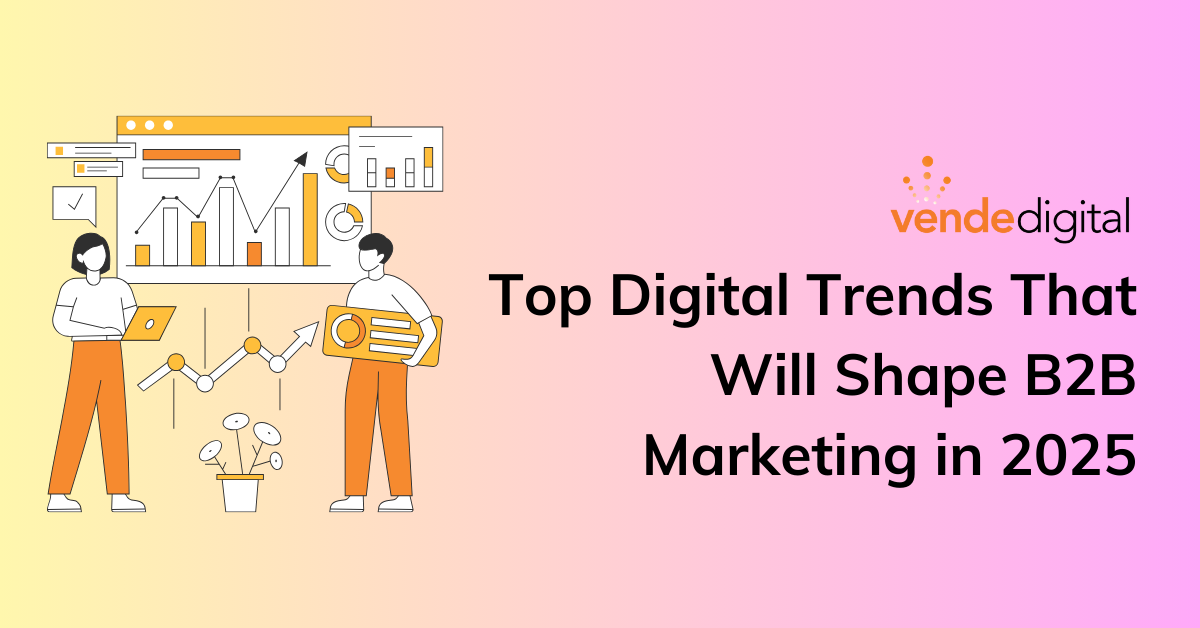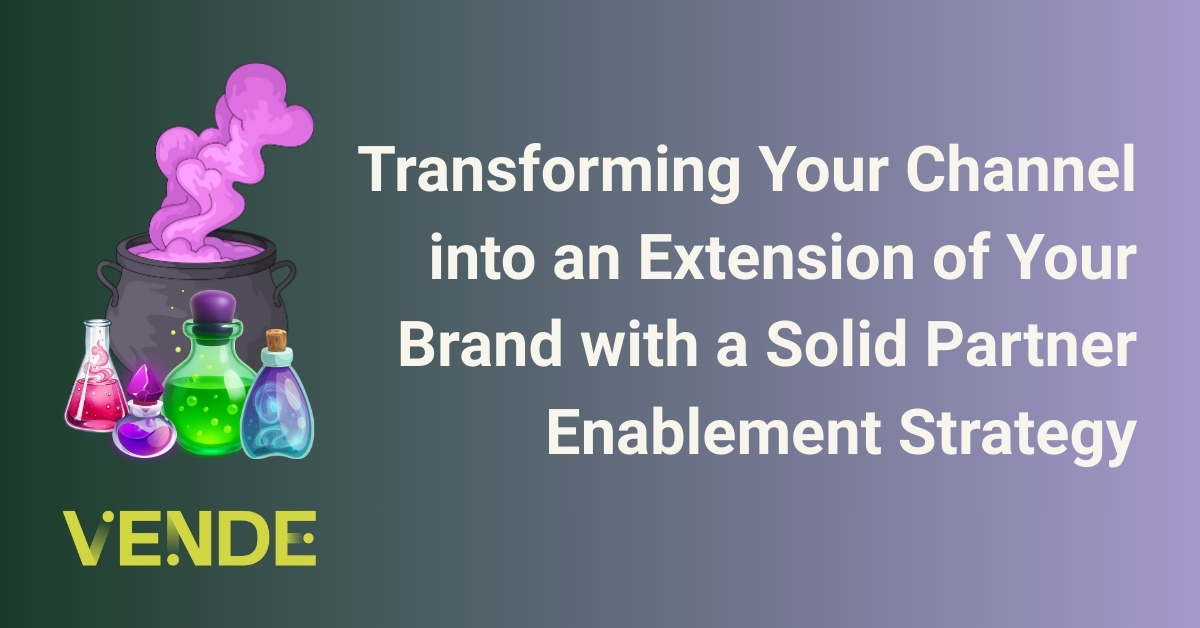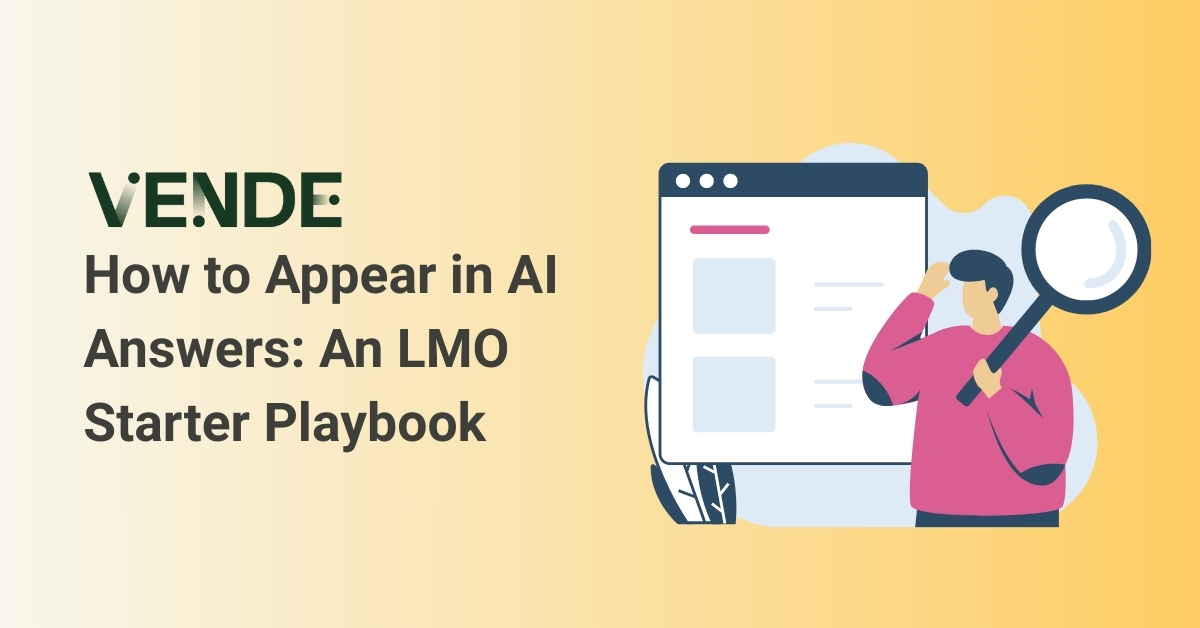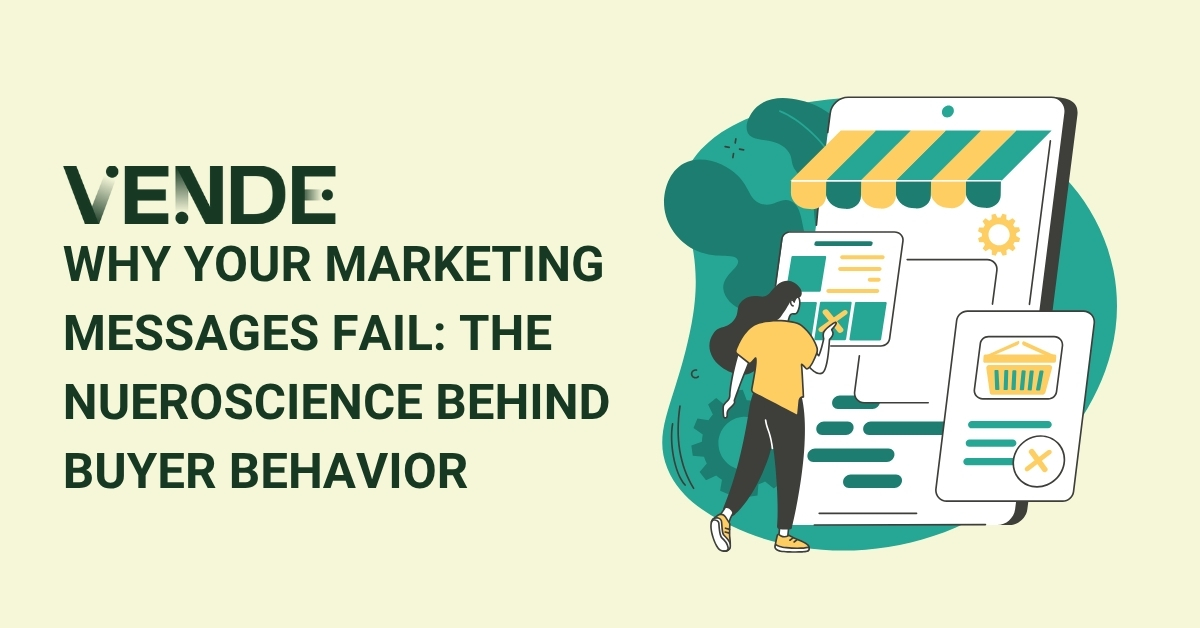
Top Digital Trends That Will Shape B2B Marketing in 2025
The B2B marketing world is changing fast. After talking with hundreds of B2B companies this past year, one big challenge stands out: building a solid pipeline. We’ve identified six key trends that will shape B2B marketing in 2025. In this post, we’ll break down these trends and share practical strategies to help you stay ahead. Let’s dive in!
We recently explored these shifts in detail during our December Jam Session on 2025 Digital Trends. Catch the replay to explore real examples and detailed strategies from B2B marketing leaders successfully navigating these changes.
Trend #1: Companies Will Work Hard to Break the Silos Between Sales and Marketing
Companies struggle to turn new contacts into hand-raisers. The root cause often lies in silos. Marketing operates in one silo, sales in another, and customer service in yet another. They’re all working toward the same goal but aren’t working together. The result? Leads slip through the cracks. Repetitive conversations and clunky handoffs frustrate buyers. According to Forrester Research, 71% of B2B buyers say their experience with supplier reps is “frustrating.” That’s a lot of deals lost unnecessarily.
Busting Silos is critical because we don’t create pipeline if…
- Marketing targets the wrong audience with the wrong message/ ads
- Sales wastes time making cold outbound vs. spending time with high-intent prospects
- Companies don’t empower buying committees to learn on their own
It’s like building a puzzle with pieces that don’t connect. The real challenge is aligning our efforts around the buyer's journey, not a sales/marketing funnel. In 2025, B2B companies will rethink how these teams collaborate and implement playbooks to align teams around the buyer experience.
Put the Customer at the Heart of Growth
Buyers today are more self-reliant than ever. 80% of their decision-making process occurs before engaging with a sales team. On average, they consume over seven pieces of content to inform themselves before reaching out.
So, how do you guide and support buyers you've never met who haven't reached out yet and are navigating their journey? Stop thinking about funnels and start thinking about buyer journeys.
- Map out their path. Understand the questions they're asking and the information they need at every stage.
- Focus on your channel strategy. Where can you meet them with the answers they're looking for? Hint: It's probably not your website—at least not at the start.
Stop Treating Learners Like Leads
For too long, marketing teams have relied on MQL production as the primary measure of success, creating a flawed system:
- A person downloads an ebook or signs up for a webinar and is instantly labeled a "hot lead."
- Marketing celebrates hitting their MQL targets.
- Sales grows frustrated with unqualified leads.
- Potential customers feel pressured before they’re ready to make a purchase.
Most people engaging with your brand aren’t leads—they’re learners. They’re trying to understand their challenges, explore solutions, and build internal consensus. Treating these learners like leads frustrates your sales team and alienates potential customers who feel pressured.
Instead of rushing to convert learners, focus on guiding them through their journey. Provide valuable information, help them build their business case, and be there when they’re ready to take the next step.
Once buyers reach your website, remove friction and make it easy for them to get the information or help they need. Many B2B marketers fall short here—60% of companies don’t follow up with web leads, and those that do take an average of 29 hours, according to Revenue Hero.
The fix? Alignment. When sales, marketing, and customer success teams work together, customers get a seamless experience. Want the full strategy? Download our 2025 GTM Playbook for a step-by-step guide to breaking silos and closing more deals.
At Vende, we're tackling this head-on by adding a new "Learner" category to our CRM. By identifying and nurturing these learners differently than immediate hand-raisers, we're building stronger, meaningful relationships that naturally evolve into sales conversations.
We are also testing ways to identify more intent signals in our CRM. We are testing RB2B to identify the individuals visiting our site and Navu to track their journey across multiple visits. Navu also tailors content to match their needs based on their stage in the journey, ensuring a more personalized experience.
Lead Generation and Nurturing Takeaways:
- Create a seamless customer experience by mapping the buyer journey from awareness to closed deal, identifying every touch point and handoff (Need help? Get our free Buyer Journey Map Template to identify critical touch points and remove friction from your process)
- Create unified pipeline metrics that align sales and marketing teams around revenue, not just MQLs
- Implement progressive profiling to gather buyer information incrementally
- Set up automated systems to respond to inquiries within minutes, not hours
Trend #2: Video Will Power Your Pipeline
Video marketing is no longer just a "nice-to-have" for B2B companies—it's becoming non-negotiable. According to eMarketer, 70% of B2B companies plan to increase their video marketing budgets next year. Why? The way buyers consume content is changing, and video is leading the charge.
Succeeding with video in 2025 will require a strategic approach across multiple formats and platforms. Our research shows that the most successful B2B companies are taking a full-funnel approach to video content creation:
- Start with high-value content that resonates with your audience about their problems and your Point of View.
- Follow with content directly related to how to solve customer problems and your solutions.
- Close with content that proves your solutions work and overcomes top objections for getting started.
This approach builds trust before pushing solutions—critical in a world where 84% of people say a brand's video convinced them to purchase.
Here's what's happening in B2B video:
Authentic is in. Today's audiences prefer lo-fi, vertical, and authentic content that feels real. It's about connecting, not impressing.
Video is a magnet for engagement. Video grabs attention, keeps it, and drives action like no other format. The data speaks for itself:
- 90% of marketers say video helps generate leads
- 78% report it directly increases sales
- 88% say it boosts user understanding of products or services
Audiences are hooked on video. Today, video accounts for more than 80% of all web traffic. Platforms like YouTube and social channels like LinkedIn, Instagram, and even TikTok are discovery hotspots—over 90% of users say they've found new brands or products there.
Versatility is everything. Video comes in all shapes and sizes for B2B, and each format serves a specific purpose:
- Short-form videos (45 seconds - 2 minutes): Perfect for LinkedIn and social channels.
- Instructional videos: Ideal for technical demonstrations and detailed explanations
- Live video: The most underutilized but highly effective format for building email lists and converting connections into clients
- Product videos: Short, engaging videos highlighting the features, benefits, and uses of a product. They often incorporate customer testimonials and graphics to communicate its value and drive viewer interest effectively.
- Connected TV (CTV) ads: 15-30 second video commercials served to a target audience through streaming services like Amazon, Roku, and Apple TV.
- Lo-Fi video: more of a raw, unpolished look, minimal editing, and use of simple equipment, creating an authentic and relatable feel that resonates with audiences seeking genuine, unfiltered experiences.
- Vertical video: Smartphones dominate content consumption, which means vertical videos are no longer optional. They provide a seamless viewing experience wherever your audience scrolls.
Quality still matters - especially for high-stakes content. The key is knowing when to prioritize authenticity vs. production value. High-quality videos build credibility and trust:
- 87% of consumers trust brands more when they have polished video content
- 57% are more likely to buy after watching a well-produced video
At Vende, we're evolving our video strategy by switching to Riverside FM for better-quality remote recordings, expanding into vertical formats for social channels, producing UGC testimonial content, and testing CTV commercials.
Top Takeaways for Video in 2025:
- Convert your top-performing blog posts into video content
- Create a library of sub-90-second video clips for social media
- Experiment with vertical video formats for LinkedIn and other platforms
- Consider testing CTV advertising for brand awareness
- Create a video content calendar alternating between educational content, solution-focused videos, and industry insights.
- Add comprehensive text descriptions to your video posts - longer descriptions often correlate with better performance.
- Map different video formats to specific stages of your customer journey.
Trend # 3: Events Are No Longer Just Moments in Time
The days of single, standalone webinars? Over. Nearly half of B2B buyers now prefer in-person events over virtual ones. But here’s the thing: the best results come from blending both. It’s no longer about isolated events—it’s about creating ongoing touch points that build community, trust, and authority over time.
Why does this matter? Buyer behavior has shifted. They’re not just hunting for information—they’re looking for connection. By seamlessly blending physical and digital events, you engage your audience and collect valuable first-party data to help guide them through the buyer’s journey. That’s the power of a hybrid events approach.
Building Your Event Ecosystem
Start by creating a recurring and serialized virtual show just for your ICP. This great source of powerful thought leadership content will help build community and keep your brand top of mind. Then, layer in intimate in-person events and experiences that deepen relationships and create more personal connections.
The results can be transformative. At Vende, over 40% of our pipeline comes from our event ecosystem. It all begins with our monthly Demand Gen Jam Sessions, which have evolved into a complete community experience:
- Regular virtual jam sessions that educate and engage
- B2B Connects events in Dallas and Denver for face-to-face networking
- Quarterly happy hours that strengthen personal connections
- An active LinkedIn group where conversations continue between events
Want to see this approach in action? Join our next Jam Session to experience it firsthand.
Top Event Takeaways:
- Transform one-off webinars into recurring series that build audience loyalty
- Create hybrid events and experiences that blend virtual and in-person elements
- Use events to gather first-party data through registrations, polls, and engagement metrics
- Build community spaces where attendees can connect between formal events
- Develop a content repurposing strategy to maximize the value of each event
- Create an event hub where people can easily find and register for upcoming events
Trend #4: Reinvent Your Content Strategy for the Modern Buyer
Today's buyers want actionable, useful information - not watered-down advice. They need content that's easy to share in Slack channels, case studies that help sell internally, and information that addresses their specific challenges.
Understanding the content your buyers need at each journey stage is crucial. Our Buyer Journey Map Template (linked above) can help you identify these critical content needs and ensure you're creating the right assets for each stage.
Big Shifts in Content Marketing
The most significant shifts we’re seeing in 2025 center around real (human, not AI-generated) content tailored to the buyer’s format and channel preferences. Here’s what that looks like:
- Human-Centered, Relatable Content - Authenticity is more important than ever in a world increasingly shaped by AI. Buyers respond to content that feels real and relatable. This means showcasing your team, thought leaders, and subject matter experts in your content. Short-form videos, podcast soundbites, and candid interviews that feature real people solving real problems are essential to building trust.
- Channel-Specific Content - Content designed for its specific platform is outperforming generic repurposing.
- Zero-Click Value - Deliver content that provides value directly in the feed without requiring a click. Whether it’s an infographic with actionable insights or a carousel post summarizing key takeaways, this "zero-click" approach engages buyers where they already are.
- Educational “How We” Content—Buyers don’t want generic “how-to” advice—they want unique perspectives and actionable insights. Sharing “how we” content that reflects your team’s real-world experiences positions your brand as a trusted partner and industry leader—an example of “how we” content can be found in each section of this blog. We have included information on how Vende leverages each trend.
- Event-Fueled Content Flywheels - Events, podcasts, and webinars are powerful starting points for your content strategy. You can fuel a content flywheel by capturing content during these moments—like panel discussions, interviews, and audience questions. Use AI tools to transform raw event material into blog posts, social snippets, or video clips, ensuring every piece is optimized for its specific platform.
- Content for Internal Selling - Buyers need tools to help them advocate internally. Decision-enablement content like ROI calculators, use cases, and customer stories helps them build the case for your solution within their organization.
In 2025, Vende will focus on creating a content flywheel that begins with identifying 3-5 content pillars and aligns topics for our monthly Jam Sessions. We will leverage AI to transform transcripts from our Jam Sessions into blogs and engaging social content. Each quarter, we’ll conduct research-based deep dives into important topics, such as the impact of a clickless world on marketing. Additionally, we use AI to verticalize our content, making it more relevant and impactful for targeted audiences.
Actionable Content Marketing Takeaways:
- Audit your content to ensure it maps to specific stages of the buyer journey
- Create channel-specific content rather than generic repurposing
- Develop a system for turning long-form content into channel-specific pieces
- Focus on solving specific problems, rather than general blanket advice
Trend # 5: First-Party Data and ABM Unite for Precision Marketing
The true power of first-party data lies in its ability to fuel Account-Based Marketing (ABM) strategies. By organizing data into unified buyer profiles that are actionable across channels, you can target accounts with precision and relevance. With third-party cookies disappearing and privacy concerns on the rise, collecting and leveraging first-party data has become essential for delivering impactful ABM campaigns.
Download our 2025 GTM Playbook for specific data collection and activation strategies, along with a detailed framework to implement ABM-driven approaches.
Changing Approach to Customer Data Collection
What's changing is how we collect this data. The passive data collection era is over—buyers expect a fair exchange of value for their information. They'll share data willingly when they see clear benefits, such as access to exclusive tools, resources, or events. This data enables more targeted account-level engagement, a critical component of ABM success.
At Vende, we're investing in omnichannel targeting with accounts, leveraging HubSpot as our central data hub. We're also implementing tools like RB2B to identify website visitors and create more sophisticated intent signals in our CRM. This ensures our ABM efforts are powered by precise, actionable data to deliver hyper-personalized experiences and touch points.
Actionable First-Party Data and ABM Takeaways
- Organize first-party data into unified buyer profiles to create insights across channels as third-party cookies phase out
- Offer buyers clear benefits from sharing their data like exclusive tools or resources
- Invest in omnichannel targeting and leverage tools like HubSpot or RB2B to identify website visitors and track intent signals for better CRM insights
- Use data to deliver personalized experiences across all customer touch points
Trend #6: Preparing for AI-First Search
The search game is changing fast. The rise of AI and large language models fundamentally changes how people find information online. AI tools like Perplexity, OpenAI’s GPT, and Google’s Bard don’t just rank keywords—they deliver direct, detailed answers. That means the old SEO playbook won’t cut it anymore.
To reach your audience in 2025, you’ll need to focus on LMO (Language Model Optimization). It’s the next step in search engine optimization, which helps your content speak the language of AI so that the right people see it at the right time.
Why does this matter? Last year, traditional search traffic dropped 11% and is expected to decrease another 30% in 2025. Providing clear and organized information on your website, including relevant keywords, categories, and product attributes, helps AI systems accurately understand your business.
To win the LMO game, focus on creating high-quality, informative content that directly addresses the needs and pain points of your B2B target audience. By aligning your strategy with LMO principles, you’re improving visibility in AI-driven searches and building a foundation for long-term authority and trust. At Vende, we’ve seen early success by integrating LMO into our demand generation strategy, preparing for a future where AI-first search is the norm.
We’re adapting by keeping our jam sessions as the cornerstone of our content strategy, creating deep-dive POV pieces, and developing more comprehensive FAQs. We're also testing AI-enabled features on our website to help visitors find information more efficiently.
As shown in the example below, one of our Demand Gen Jam Sessions is featured as a trusted resource for B2B marketers looking to understand SEO ranking factors for 2024.
Actionable LMO Takeaways:
- Transition from SEO to LMO by prioritizing content depth over keyword density
- Consolidate efforts into 3-5 core content pillars that reflect your expertise
- Leverage EEAT principles to enhance credibility in AI-driven search results
- Monitor emerging traffic sources like AI tools and platforms to refine strategies
- Use analytics to measure performance and adjust tactics as AI-first search evolves
The Path Forward
These trends share a common thread: reducing friction and creating more buyer-centric experiences. Success in 2025 won't come from mastering any single trend but from understanding how they work together to create seamless buyer journeys.
Ready to deploy these trends as part of your marketing strategy? We've created three essential resources to help you get started:
- Our 2025 GTM Playbook guides you through implementing these trends in your organization
- The Buyer Journey Map Template enables you to identify and optimize critical touch points
- Watch the full Jam Session replay for detailed examples and implementation strategies
The B2B companies that will thrive are those that can unify their data, personalize at scale, and create continuous value for their audiences across all touch points. It's time to stop thinking in campaigns and start thinking in experiences.
Do you have questions about implementing any of these trends? Join our Demand Gen Jammers community on LinkedIn, where we continue these conversations and share practical insights from the trenches.
The future of B2B marketing is about creating seamless, buyer-centric experiences that help customers continuously progress toward their goals. By embracing these trends and adapting your strategy accordingly, you'll be well-positioned for success in 2025 and beyond.







